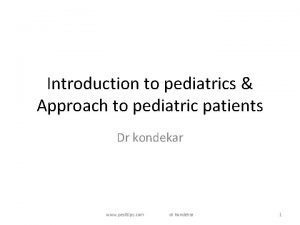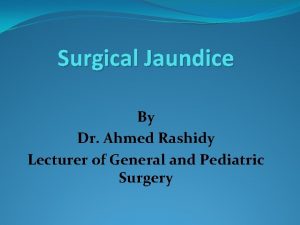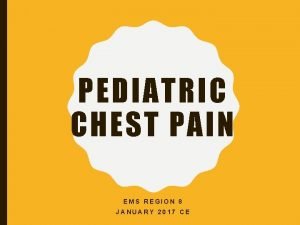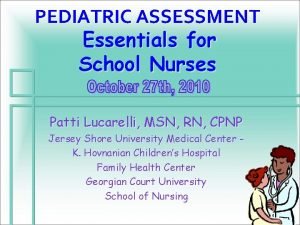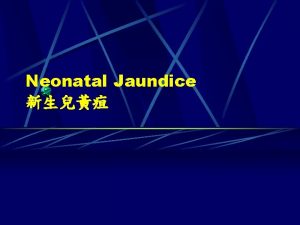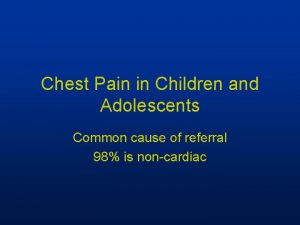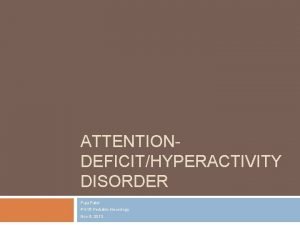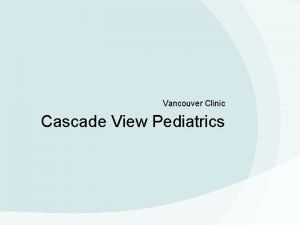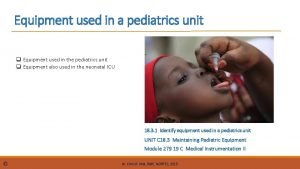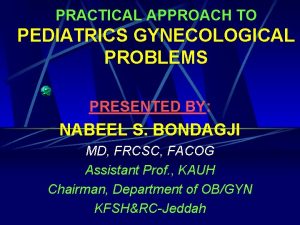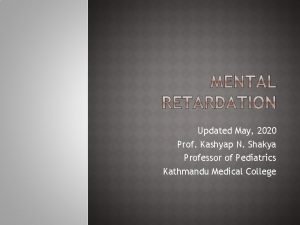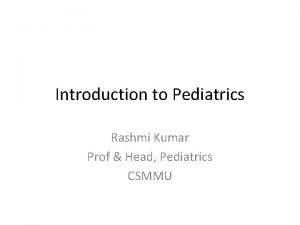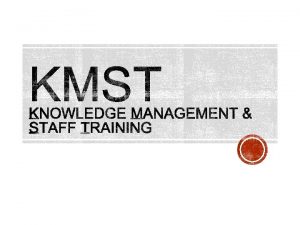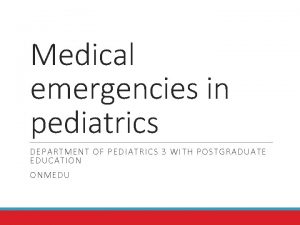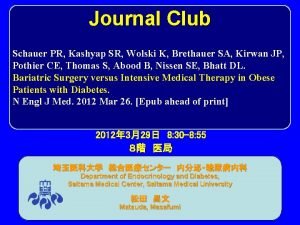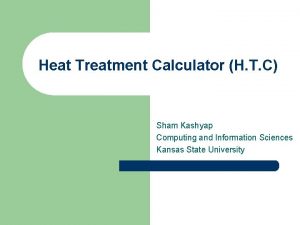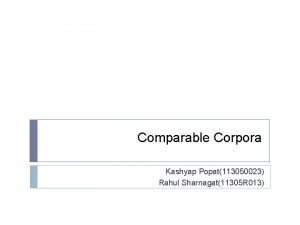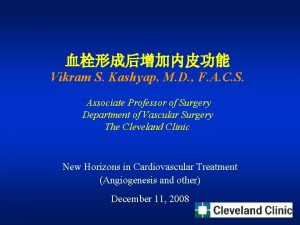Introduction to Pediatrics Updated May 2020 Prof Kashyap






























- Slides: 30

Introduction to Pediatrics Updated May, 2020 Prof. Kashyap N. Shakya Professor of Pediatrics Kathmandu Medical College

Pediatrics As a subject: Pediatrics is the sole discipline concerned with all aspects of the well-being of infants, children, and adolescents This includes their: health physical, mental, and psychologic growth and development opportunity to achieve full potential as adults

Concern for all aspects of children Organ systems and biologic processes Environmental and social influences, which have a major impact on: physical emotional mental health social well-being of children and their families

World child population World population (2018) is 7. 6 billion Growing at the rate of 1. 21%/yr Children < age 15 yr: 1. 9 billion (25. 6%)

Nepal Demographics Profile 2014 Population 30, 986, 975 (July 2014 est. ) Age structure 0 -14 years: 31. 6% (male 4, 989, 268/female 4, 805, 381) 15 -24 years: 22. 6% (male 3, 521, 421/female 3, 484, 203) *Mortality rate, infant (per 1, 000 live births) 2011 -35 2012 -33 2013 - 32 2014 -31 2015 -29 *Reference: The Data Catalog is a listing of available World Bank datasets Infant mortality rate of Nepal (2017): 27. 9/1000 live births

Nepal vital statistics (Unicef) Neonatal mortality rate (2012): 24 U 5 MR (2012): 42

Nepal Demographic and Health Survey 2016 (Key points) Early Childhood Mortality: Neonatal mortality rate: 21 deaths per 1, 000 live births Infant mortality rate: 32 per 1, 000 live births Under-5 mortality rate: 39 per 1, 000 live births. 82% of all deaths among children under age 5 in Nepal take place before a child’s first birthday, with 54% occurring during the first month of life.

Nepal: Trends in Childhood Mortality 1991 - 2016

Scope of Pediatrics emerged as a medical specialty in response to increasing awareness that: health problems of children differ from those of adults a child's response to illness and stress varies with age Declaration of the Rights of the Child issued by the United Nations in 1959 recognizing that children everywhere have fundamental needs and rights

Topics in Pediatrics General Pediatrics Neonatology Systemic Pediatrics Community and Social Pediatrics Pediatric subspecialities: Pediatric Surgery Pediatric psychiatry Emergency Pediatrics Critical care Pediatrics Pediataric Oncologly Pediatric Hematology

Clinical postings in Pediatrics Four weeks posting in each of the following semesters: Fifth Sixth Eighth Ninth

Pediatrics- evaluation KU Examination: Theory marks: total- 100 marks Theory paper -80 marks Internal assessment – 20 marks Practical marks: total- 100 marks Examination- 80 marks Internal assessment- 20 marks

Pediatrics- teaching/ learning Teaching program: Morning clinical/ bedside class Daily clinical teaching throughout posting Diagnostic methods- case discussion Lecture class weekly As per monthly lecture schedule Daily afternoon tutorial class throughout posting On prior arranged topic for discussion Problem based learning

Pediatrics Theory Examination Marks aloted and topic distribution- in University examination: MCQ s 30 Questions (1 mark each) 1. Neonatology 7 Questions 2. General Pediatrics 8 Questions 3. Systemic Pediatrics 10 Questions 4. Social Pediatrics 5 Questions SAQs 5 Questions x 6 = 30 marks (at least one from each topic) 1. Neonatology 2. General Pediatrics 3. Systemic Pediatrics 4. Social Pediatrics MEQ/ PBQ 2 Questions x 10 = 20 marks 1. One from Neonatology/ General Pediatrics 2. One from Systemic Pediatarics/ Social Pediatraics

Practical Examination: 1. Long case: 1 in number = 30 marks 2. Short Cases: 2 in number: 5 marks each = 10 marks 3. OSPE: 2 in number: 5 marks each = 10 marks 4. OSCE : 15 marks 5. VIVA: 15 marks Total: 80 marks

KU Examination- Pediatrics Theory Paper- 80 marks MCQs 30 questiions (one mark each)= 30 marks SAQs 5 questions x 6= 30 marks MEQ/PBQ 2 questions x 10= 20 marks Total: ………………………. 80 marks Practical Examination 80 marks Long cases: 1 in no: = 30 marks Short cases: 2 in no: 5 marks each = 10 marks OSPE : : 2 in no: 5 marks each = 10 marks OSCE 15 marks Viva 15 marks Total: ……………………… 80 marks

Books for Study

Recommended text books

There are 31 chapters in the Ghai Pediatrics with an Index 1. Introduction to Pediatrics 2. Normal Growth and its Disorders 3. Development 4. Adolescent Health and Development 5. Fluid and Electrolyte Disturbances 6. Nutrition 7. Micro-nutrients in Health and Disease 8. Newborn Infants 9. Immunization and Immunodeficiency 10. Infections and Infestations 11. Diseases of Gastrointestinal System and Liver 12. Hematological Disorders 13. Otolaryngology 14. Disorders of Respiratory System 15. Disorders of Cardiovascular System 16. of Neonatal and Childhood Illness 17. Rights of Children 1. Disorders of Kidney and Urinary Tract 2. Endocrine and Metabolic Disorders 3. Central Nervous System 4. Neuromuscular Disorders 5. Childhood Malignancies 6. Rheumatological Disorders 7. Genetic Disorders 8. Inborn Errors of Metabolism 9. Eye Disorders 10. Skin Disorders 11. Poisonings, Injuries and Accidents 12. Pediatric Critical Care 13. Common Medical Procedures 14. Rational Drug Therapy 15. Integrated Management

PEDIATRIC S BOOKS


Reference books

Pediatric Clinical Methods


General Clinical Methods

Different Age Groups in Pediatrics Pediatric Age Group Newborn Infant Age Range 0 -28 days 1 to 12 mo Toddler Preschool child School age child Adolescent 1 -3 yr 3 -6 yr 6 -12 yr 10 -19 yr


Neonatology

Neonatology Definitions Terms used Birth weight Low birth weight < 2, 500 g Very low birth weight < 1, 500 g Extremely low birth < 1, 000 g weight

Thank You
 Thoreum bsc
Thoreum bsc Cse 340 principles of programming languages
Cse 340 principles of programming languages Arti kashyap iit mandi
Arti kashyap iit mandi The symbol tsfa in alu operations include
The symbol tsfa in alu operations include Performance monitoring and coaching form 2021
Performance monitoring and coaching form 2021 Introduction to pediatrics
Introduction to pediatrics Normal adult vital signs
Normal adult vital signs Respiratory rate normal range
Respiratory rate normal range Type of jaundice
Type of jaundice Mummy restraint ppt
Mummy restraint ppt Im injection sites and volumes pediatrics
Im injection sites and volumes pediatrics Chest pain in pediatrics
Chest pain in pediatrics Normal values of vital signs
Normal values of vital signs Pain scale with words
Pain scale with words Neonatal jaundice physical examination
Neonatal jaundice physical examination What is the modern concept of pediatrics
What is the modern concept of pediatrics Concept of pediatric nursing
Concept of pediatric nursing Neurology shelf percentiles
Neurology shelf percentiles Chest pain in pediatrics
Chest pain in pediatrics Central valley pediatrics
Central valley pediatrics Im injection sites and volumes pediatrics
Im injection sites and volumes pediatrics Trends in pediatric nursing 2020
Trends in pediatric nursing 2020 Neonatal sepsis nelson pediatrics
Neonatal sepsis nelson pediatrics Duke pediatrics durham nc
Duke pediatrics durham nc 11yo
11yo Vancouver clinic pediatrics
Vancouver clinic pediatrics Equipment used in pediatrics
Equipment used in pediatrics Lsuhsc pediatrics
Lsuhsc pediatrics Himalaya vigorcare side effects
Himalaya vigorcare side effects Nelson pediatrics
Nelson pediatrics Practical approach pediatrics
Practical approach pediatrics





